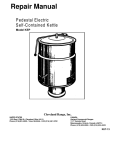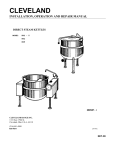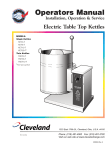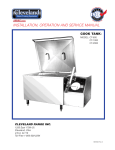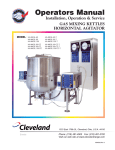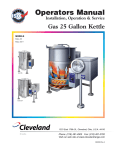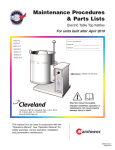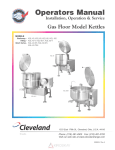Download Cleveland KGL-T Repair manual
Transcript
INSTALLATION, OPERATION AND REPAIR MANUAL GAS KETTLE MODEL # KGL KGL-T CLEVELAND RANGE INC. 1333 East 179th St. Cleveland, Ohio U.S.A. 44110 (216)481-4900 222-01CO 9102 REV:0 KET-07 IMPORTANT THE FOLLOWING POINTS ARE TO INSURE THE SAFE INSTALLATION AND OPERATION OF THIS EQUIPMENT : INSURE ALL GAS AND ELECTRICAL SUPPLIES MATCH RATING PLATE AND ELECTRICAL STICKERS OBSERVE ALL CLEARANCE REQUIREMENTS DISCONNECT THE ELECTRICAL POWER SUPPLY TO THE APPLIANCE BEFORE CLEANING OR SERVICING UNIT ONLY A QUALIFIED SERVICE TECHNICIAN SHOULD REPAIR UNIT THE INSTALLATION AND CONNECTION MUST COMPLY WITH LOCAL CODES, OR IN THE ABSENCE OF LOCAL CODES, WITH CAN1 B149 INSTALLATION CODE OR WITH THE NATIONAL FUEL GAS CODE, ANSI 2223.1-1988. POST IN A PROMINENT LOCATION, INSTRUCTIONS TO BE FOLLOWED IN THE EVENT THE USER SMELLS GAS. THIS INFORMATION SHALL BE OBTAINED BY CONSULTING YOUR LOCAL GAS SUPPLER. THE APPLIANCE AND ITS INDIVIDUAL SHUT OFF VALVE MUST BE DISCONNECTED FROM THE GAS SUPPLY PIPING SYSTEM DURING ANY PRESSURE TESTING OF THAT SYSTEM AT TEST PRESSURES IN EXCESS OF 1/2 PSIG. (3.45 KPA). THE APPLIANCE MUST BE ISOLATED FROM THE GAS SUPPLY PIPING SYSTEM BY CLOSING ITS INDIVIDUAL MANUAL SHUT OFF VALVE DURING ANY PRESSURE TESTING OF THE GAS SUPPLY PIPING SYSTEM AT TEST PRESSURES EQUAL TO OR LESS THAN 1/2 PSIG (3.45 KPA). RETAIN THIS MANUAL FOR YOUR REFERENCE. 1 FOR YOUR SAFETY Gas fired kettles are only to be installed under a ventilation hood in a room which has provisions for adequate make up air. DO NOT STORE OR USE GASOLINE OR OTHER FLAMMABLE LIQUIDS AND VAPOURS IN THE VICINITY OF THIS OR ANY OTHER APPLIANCE. Electrical installation must be in accordance with local codes and/or the National Electric Code ANSI/NFPA 70-1987 (USA) or the Canadian Electrical Code CSA Standard C22.1 (Canada). The kettle must be electrically grounded by the installer. Standard supply voltage is 115 volts A.C. However, optional A.C. voltages can be supplied on special order. A separate fused disconnect switch must be supplied and installed in the high voltage electrical supply line. The wire gauge size and electric supply must match the power requirements specified on the kettle's rating plate. The conduit-enclosed permanent copper wiring must be adequate to carry the required current at the rated voltage. Refer to the specification sheet for electrical specifications and location of electrical connections. - -IF YOU SMELL GAS - 1. OPEN WINDOWS 2. DO NOT TOUCH ELECTRICAL SWITCHES. 3. EXTINGUISH ANY OPEN FLAME. 4. CALL YOUR GAS SUPPLIER IMMEDIATELY. GENERAL INSTALLATION INSTRUCTIONS Installation of kettle must be accomplished by qualified installation personnel, working to all applicable local and national codes. Improper installation of product could cause injury or damage. INSPECTION Before unpacking visually inspect the unit for evidence of damage during shipping. If damage is noticed, do not unpack the unit, follow shipping damage instructions. This equipment is built to comply with applicable standards for manufacturers. Included among those approval agencies are: UL, A.G.A, NSF. ASME/N.Bg, CSA, CGA, ETL, and others. Many local codes exist, and it is the responsibility of the owner and installer to comply with these codes. SHIPPING DAMAGE INSTRUCTIONS If shipping damage to the unit is discovered or suspected, observe the following guidelines in preparing a shipping damage claim. Observe all clearance requirements to provide proper make-up air flow as well as sufficient clearance for servicing. Dimensions and clearance specifications are shown on the specification sheet. Do not install kickplates or otherwise obstruct the flow of combustion and ventilation air. Check the rating plate to ensure that the kettle has been equipped to operate with the type of gas available at the installation. 1. 2. 2 Write down a description of the damage or the reason for suspecting damage as soon as it is discovered. This will help in filling out the claim forms later. As soon as damage is discovered or suspected, notify the carrier that delivered the shipment. 3. Arrange for the carrier's representative to examine the damage. 4. Fill out all carrier claims forms and have the examining carrier sign and date each form. pipe joint compound which is resistant to L.P. gas. Test all pipe joints for leaks with soap and water solution. Ensure that the gas pressure regulator is set for the manifold pressure indicated on the gas rating plate. The appliance and its individual shut-off valve must be disconnected from the gas supply piping system during any pressure testing of that system at test pressures in excess of 1/2 psi (3.45 kPa). The appliance must be isolated from the gas supply piping system by closing its individual manual shutoff valve during any pressure testing of the gas supply piping system at test pressures equal to or less than 1/2 psi (3.45 kPa). INSTALLATION The first installation step is to refer to the specification sheet for clearance requirements, in order to determine the location of the kettle. Next, carefully cut open the shipping carton for easy removal of the kettle. ELECTRICITY Position the kettle in its permanent location, and level the kettle by tuning the adjustable feet. Remove the two screws securing the console cover, and remove the cover. A wiring diagram is affixed to the inside of the cover. Feed conduit-enclosed permanent copper wiring through the cutout in the bottom of the console and fasten to the terminal block. Fasten the ground wire to the ground lug, connected to the frame, beside the terminal block. Replace the console cover and secure it with the screws. Once positioned and leveled, permanently secure the kettle's flanged feet to the floor using 5/16 x 2 1/2 inch lag bolts and floor anchors (supplied by the installer). Three bolts per leg are required to secure each of the flanged feet. WATER GAS The sealed jacket of the gas-fired kettle is precharged with the correct amount of a water-based formula, and therefore, no water connection is required to the kettle jacket. It is recommended that a sediment trap (drip leg) be installed in the gas supply line. If the gas pressure exceeds 14" water column, a pressure regulator must be installed, to provide a maximum of 14" water column gas pressure to the gas control valve. Connect the gas supply piping to the input side of the gas control valve. Location and pressure data are shown on the specification sheet. Installation must be in accordance with local codes and/or the National Fuel Gas Code ANSI Z223.1-1984 (USA) or Installation Codes for Gas Burning Appliances and Equipment CANI B149.1 and B149.2 (Canada). Use a gas 3 and the gas burners have been automatically shut off by the kettle's safety circuit. Water must be added to the reservoir before further use. Refer to the "Reservoir Fill Procedures" for details. OPERATION 1. Before turning the kettle on, read the vacuum/pressure gauge. The gauge's needle should be in the green zone. If the needle is in the "vent air" zone, call your service agent to locate and repair the source of the leak. Under normal circumstances the kettle should operate for years without venting. 2. Ensure that the electrical service to the kettle is turned on. 3. Place the kettle's power on/off switch to the "ON" position. 6. Turn the temperature control knob to the required temperature setting. The green light will cycle on and off with the solid state control, indicating the burners are cycling on and off to maintain the set temperature. 8. Pour the contents of the kettle into an appropriate container by opening the draw-off valve. Care should be taken to pour slowly enough to avoid splashing of the product. CARE AND CLEANING NOTE: When cooking egg and milk products, the kettle should not be preheated, as products of this nature adhere to hot cooking surfaces. These types of food should be placed in the kettle before heating is begun. Place product into the kettle. When cooking is completed, turn knob to minimum and place the power on/off switch to the "OFF" position. NOTE: As with cleaning food soil from any cookware, an important part of kettle cleaning is to prevent foods from drying on. For this reason, cleaning should be completed immediately after cooked foods are removed. Refer to the "Care and Cleaning Instructions" for detailed kettle washing procedures. 4. Pre-heat the kettle by turning the temperature control knob to the desired temperature setting. The green light will remain lit (indicating the gas burners are ignited) until the temperature setting is reached. When the green light goes off, the burners are off, and pre-heating is complete. 5. 7. Your Cleveland kettle must be cleaned regularly to maintain its fast, efficient cooking performance, and to ensure its continued safe, reliable operations. NOTE: The red "low water" light should not be lit during kettle operation. This light indicates that the water level has reached a critically low level, 4 1. Prepare a warm water and mild detergent solution in the kettle. 2. Remove food deposits inside the kettle using a nylon brush. Do not use a metal bristle brush, as this may permanently damage the kettle's stainless steel surface. 3. Loosen food which is stuck to the kettle by allowing it to soak at a low temperature setting. 4. Open the draw-off valve to drain the wash water. 5. The draw-off valve should be cleaned as follows: a. Remove the drain screen from the bottom of the kettle. Thoroughly wash and rinse the screen, either in a sink or dishwasher, then replace it into the kettle. b. Disassemble the draw-off valve, first by turning the valve knob counter-clockwise, then turning the large hex nut counter-clockwise, until the valve stem is free of the valve body. c. In a sink, wash and rinse the valve stem, hex nut, and knob. Wash and rinse the inside of the valve body using a nylon brush. d. Do not allow water to run into electrical controls. Always turn off equipment power before using water to wash equipment. DO NOT HOSE DOWN THE KETTLE. NOTE: For more difficult cleaning applications, one of the following can be used: alcohol, baking soda, vinegar, or a solution of ammonia in water. Avoid the use of chloride cleansers, which may damage the kettle's stainless steel surface. WARNING: Steel wool should never be used for cleaning the kettle. Particles of the steel wool become embedded in the surface and rust. This will weaken and corrode the stainless steel surface. MAINTENANCE Cleveland kettles require very little preventive maintenance, other than daily cleaning. Reassemble the draw-off valve by reversing the procedure for disassembly. The valve's hex nut should be hand tight only. 6. Rinse the kettle interior thoroughly, then drain the rinse water. 7. Leave the cover and draw-off valve open when the kettle is not in use. 8. Exterior Care: Allow kettle to cool before washing. Use the same cleaners and cleaning procedures as for other kitchen surfaces of stainless steel and aluminum. Mild soapy water, with a clear water rinse, is recommended. DRAW-OFF VALVE MAINTENANCE To correct a leak at the draw-off valve, the source of the leak must first be determined. Leaks from around the valve stem are corrected by simply replacing the "O"ring. Faulty seating of the valve stem disc against the valve body seat may cause dripping from the valve even when the valve is tightly closed. This can often be corrected by cleaning any residue from the disc and seat. Our Company supports a worldwide network of Maintenance and Repair Centres. Contact your nearest Maintenance and Repair Centre for replacement parts, service, or information regarding the proper maintenance and repair of your cooking equipment. 5 In order to preserve the various agency safety certification (UL, A.G.A., CSA. CGA, NSF, ASME/Ntl. Bd., etc.), only factory-supplied replacement parts should be used. The use of other than factory-supplied replacement parts will void the warranty. gauge shows at least 5 psi pressure. Any bubbles which appear will indicate a leak. RESERVOIR FILL PROCEDURES The reservoir's water level must be maintained at the proper level. Under normal operating conditions, the sealed water reservoir should not require the addition of water. If the red "low water" light comes on during use, the water level has reached a critically low level. The low water protection control has automatically shut off the gas burners. The following procedure must be completed before further use: KETTLE VENTING INSTRUCTIONS If the vacuum/pressure gauge reading is in the "vent air" zone, it means that air has entered the steam/water jacket, resulting in little or no vacuum. This reduces kettle efficiency by slowing its heating process. To remedy this situation, the following venting procedures should be followed: 1. WARNING: Insure there is no pressure IN the unit before removing filler cap. With the temperature control knob set at number 9, heat the empty kettle until the vacuum/pressure gauge indicates 5-10 psi. 2. Release steam and air from the steam/water jacket by pulling out on the pin of the safety valve for approximately 10-15 seconds. The kettle's steam and air from the steam/water jacket should now be free of air. At room temperature, the pressure gauge needle should rest in the green zone, indicating a vacuum in the kettle's jacket. To check the gauge for proper vacuum after venting, the temperature can be quickly reduced by filling the kettle with cold water. 1. Shut off power to the kettle. 2. Remove water fill cap located at the rear of the kettle. 3. Add distilled water until the water level is between the "HI" and "LO'' markings on the sight gauge glass. 4. Replace the water fill cup and carefully tighten. Do not over-tighten. 5. Restore power to the kettle. 6. The kettle must now be vented. Refer to the "Kettle Venting Instructions". CAUTION: It is recommended that only distilled water be used when adding water to a partially filled water reservoir. Local tap water conditions may cause kettle damage which is not covered under warranty. Add water until the level is between the "HI" and "LO" marks on the sight gauge. If the kettle will not hold vacuum, have a qualified service technician test for leaks at the water fill plug, sight gauge, safely valve, probe, and vacuum/pressure gauge fittings. We suggest mixing a 50/50 solution of liquid detergent and water while heating the kettle to at least 5 psi pressure. Then, shut off power to the kettle. The soapy solution should be applied to the suspected area while the 6 PARTS LIST - ELECTRICAL COMPONENT BOX ASSEMBLY ITEM NO. 1. 2. 3. 4. 5. 6. 7. 8. 9. 10. 11. PART NO. KE51141 KE52690 KE53469 KE00458 KE50753 KE53316 FI 05050 KE53436 KE51164 KE52281 KE51139 DESCRIPTION Transformer, 120-16V. Bushing Ignition module Solid state control Relay Safety thermostat Brass nut # 7/16-24 Air switch Transformer 120-24V. Fuse bussman MDL-1/2 amp Fuse holder QTY. 1 1 1 1 1 1 1 1 1 1 1 PARTS LIST - PRESSURE RELIEF ASSEMBLY ITEM-NO. 1. 2. 3. 4. 5. 6. 7. 8. 9. 10. 11. 12. 13. PART NO. FI05215 FI05225 FI00151 KE51014 FI00596 FI05214 RT00370 KE51723 FI00598 FI052l6 FI05224 FI05221 FI05050 DESCRIPTION Cap, 1/2" Nipple, 1/2" Street elbow, 1/2" Check valve Nipple Cross tee Tubing, 1/4" copper(per ft.) Safety valve, 50 p.s.i Nipple Elbow, FIP x FIP Nipple Reducer, 1/2" pipe to 1/4" tube Compression nut, 1/4" QTY. 1 1 2 1 1 1 3 1 1 1 1 1 1 PARTS LIST - GAS CONTROL ASSEMBLY ( KETTLE ) ITEM NO. 1. 2. 3. 4. 5. 6. 7. 8. 9. 10. 11. 12. 13. 14. 15. 16. 17. 18. 19. 20. PART NO. KE53402 KE53402-1 KE01426 KE53387 KE53515 KE535151 F01518 KE53441 KE53422 KE53403 KE53403-1 KE53403-2 KE53403-3 FA00114 FI00073 DESCRIPTION Air orifice, 140K BTU burner Air orifice, 170K BTU burner Mixing chamber Swivel Pipe Gas control valve, N.G. Gas control valve, L.P. Shut-off valve Reducer Pipe Pipe Blower Elbow Pipe Elbow Plug "O" Ring Spring Orifice, .227, N.G., 140K BTU, 2000 ft. Orifice, .228, L.P., 140K BTU, 2000 ft. Orifice, .303, N.G., 170K BTU, 2000 ft. Orifice, .246, L.P., 170K BTU, 2000 ft. "O" Ring Pipe Union QTY. 1 1 1 1 1 1 1 1 1 1 1 1 1 1 1 1 1 1 1 1 GAS CONTROL ASSEMBLY ( KETTLE ) PARTS LIST - SIDE BOX ASSEMBLY (KETTLE) ITEM NO. 1. 2. 3. 4. 5. 6. 7. 8. 9. 10. 11. 12. 13. 14. 15. 1617. 18. 19. 20. 21. 22. 23. 24. 25. 26. 27. 28. 29. 30. 31. PART NO. N/A KE53437 KE01432 KE00515 KE517111 KE52833 KE50315 KE50245 KE51738 FA10623 FA20029 FA950551 FA95008 FA30088 FA95050 KE52191 KE52192 KE52193 KE51891 KE517112 KE51730 FA19186 KE503752 KE50569-1 KE50569 SE00074 KE51005 FA32027 KE50567 KE00508 KE50429 SK50055 KE50504 SK50062 KE50568 KE50473 KE50556 KE50955-1 KE52871 KE51053 FA05002-30 32 33. FI00196 DESCRIPTION Sight glass Igniter Enclosure cover assembly Thermistor R.H. Trunnion bearing Gear Worm Bearing Sleeve, bearing Bolt, hex bead Nut Key Locknut Washer Retaining ring Bearing Thrust washer Thrust washer spacer Washer L.H. Bearing Tilt shaft bearing Screw, hex socket Tilt shaft Temperature Control Assembly Knob Potentiometer Seal Star Washer L.E.D., red Hand wheel Pressure gauge Terminal block Switch Assembly Toggle switch Rubber Boot L.E.D., green Ground lug Water level probe Retaining cover Washer Sight glass "O"-Ring Electrical Component Box Assy. (See Pg. 222-09TD) Drain cap QTY. 1 1 1 1 1 1 1 1 1 1 1 1 2 1 1 2 4 3 1 1 1 1 1 1 1 1 1 1 1 1 1 1 1 1 1 1 1 1 1 1 1 SIDE BOX ASSEMBLY ( KETTLE ) PARTS LIST - 2" TANGENT DRAW-OFF VALVE ITEM NO. PART NO. 1. to 7. KE50972-B KE509721 1. FA21008 FA95049 FA11134 2. KE527551 3. KE52754 4. KE52753 5. KE52752 KE53290 6. FA00111 7. KE52751 KE53289 DESCRIPTION Draw-off assembly Draw-off assembly, for KDM-40-T Hex nut Wing nut Screw, for KDM-40-T Knob Hex nut Retainer Piston Piston, for KDM-40-T ''O"Ring Valve body Valve body, for KDM-40-T QTY. 1 1 1 1 1 1 1 1 PARTS LIST - HINGE ASSEMBLY ITEM NO. 1. - 9. 1. 2. 3. 4. 5. 6. 7. 8. 9. 10. 11. 12. 13. 14. PART NO. KE00598 SK00168 KE51218 KE50824 KE50823 KE50820 KE50819 FA11507 FA11284 KE50122 KE50121 KE50821 KE50151 KE00095 FA30500 FA11223 DESCRIPTION Hinge assembly (40 gal. and under) Hinge assembly (60 gal. and over) Body, spring assist hinge Hinge bearing Pin (hinge) Insert, brass adjustment End piece Screws, adjustment Bolts, end block Spring (40 gal. and under) Spring (60 gal. and over) Cylinder Knob, ball type Cover handle (specify model) Lid holder Washer, lid holder Bolt, lid holder QTY. 1 1 1 1 1 1 1 2 2 1 1 1 1 1 1 1 1


















